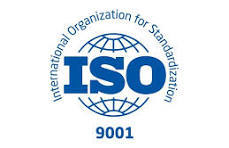
What is Freight Forwarder ?
Freight forwarders are intermediaries between shippers (manufacturers, wholesalers, or retailers) and carriers (sea, air, and land transportation providers) that organize and coordinate the movement of goods across international borders. So freight forwarders don’t actually ship freight, but they serve as experts that arrange one or several transportation modes and can sometimes provide other logistics services including
- inland transportation from origin and/or to destination,
- goods storage,
- preparation of customs and other documentation,
- freight consolidation and deconsolidation,
- container tracking,
- insurance services,
- import customs clearance, and so on.
Shippers can definitely arrange transportation of their goods themselves and save on the commission, but it often turns out that outsourcing it to professional freight forwarders pays off in the long run. That’s because their expertise and established relationships with carriers allow them to move freight in the cheapest, fastest, and most reliable way.
Before we get to describing the typical freight forwarding process, let’s clear up a few more terms.
F

Freight forwarding process
Application, quotation, and contract signing. As we’ve mentioned, typically, it’s the shipper who hires the freight forwarder to arrange transportation and ensure goods are delivered safely. To initiate cooperation, Jack sends Sam a request for a quotation (RFQ) that lists all the required services. Sam replies with a quote and after settling all the details, the parties sign the contract of carriage.
Documents: RFQ, quote, contract
Cargo pickup. Sam organizes the pickup from Jack’s facility (factory, warehouse, etc.) and hauls goods to his own storage location for further handling. Jack must provide all the related documents of the goods needed for customs clearance and international transportation.
When goods are being picked, Sam issues a house BOL as evidence of goods receival and hands it to Jack. A BOL is a legally binding document and the most important piece of paperwork in international trade which serves as a proof of ownership.
Documents: house BOL
Storage and consolidation. Sam keeps goods at his warehouse (luckily, Jack’s clothing doesn’t require any special storage conditions like some temperature-sensitive products do) and waits for more loads to consolidate them. He knows that combining multiple less-than-container loads from different shippers into one full-container load can significantly cut shipping costs.
Transporting goods to the port. Depending on the mode of transportation he has arranged, Sam organizes inland haulage of goods to the marine port, airport, or rail terminal. Usually, it’s done before customs clearance, but not necessarily.
Export customs clearance. When it’s time to ship the goods, Sam (being an authorized customs broker too) prepares and submits the export documentation. He knows all the requirements, rules, and regulations of various countries and makes sure that nothing gets overlooked and that all customs procedures are handled correctly. He also consults Jack on export taxes and duties or pays them on his behalf.
Documents: export declaration, export permit, proforma/commercial invoice, packing list, proof of origin, insurance certificate, etc.
Handing over to the carrier. After the goods are cleared, they can be handed over to the carrier. Depending on the transportation mode, the carrier issues a master BOL which can be an air waybill (AWB), marine BOL, or rail waybill. Sam collects the BOL and sends its originals to Jack and the receiver.
Documents: master BOL
Tracking shipment en route. Sam knows how important it is for Jack to know where the goods are, so he regularly keeps him posted with updates on the shipment location and ETA.
Import customs clearance. When the goods arrive in the country of destination, they have to be cleared again, so Sam hires the local customs broker to perform all the required clearance procedures.
Documents: proforma/commercial invoice, proof of origin, master BOL, customs value declaration, insurance certificate, etc.
Inland haulage to the receiver. Once customs releases the goods, Sam organizes inland haulage (by rail or truck) to the point of destination. The receiver presents his copy of the BOL to prove the right to claim the shipment.
Documents: master BOL
As you can see, the freight forwarding business isn’t a cakewalk. There’s a lot of hustle and bustle involved in the process itself, not to mention the inevitable disruptions that always happen in supply chains and require immediate reaction. So today, specialized software that helps automate most of the freight forwarding workflows is a real lifesaver. Let’s see how it can help.
Freight forwarding software and its key features
Digital technology can’t ship freight or pack goods into a container. However, software solutions can streamline most of the freight forwarder’s daily operations facilitating the entire process – from quotation to invoicing. Its most valuable benefits are
- document generation,
- ease of data exchange and communication with shippers and carriers, and
- having all information in one system so that you get the fullest picture of your activities.
Typically, such platforms include several key modules that cover logistics operations, customer relationships, and accounting. But we’ll look a bit deeper and discuss the most important and sought after features.
Rate quote generation
The freight forwarding business isn’t a coffee shop with clear, set prices. The rate quote depends on a lot of factors such as the type of commodity, amount of goods to be shipped, preferred carrier and country of destination, and most importantly, the range of services required.
Calculating quotes for each separate case can take forever if done manually, but software automates this process and helps you generate a quote once you know all the customer requirements.
You can set up custom business rules with your company’s charges, tariffs, and markups. Besides, modern platforms integrate with multiple carriers to have their current rates. So, when you get a request, you can quickly generate a quote for any transportation mode (or multimodal shipping) and see a detailed charge breakdown.
Order management
Once the shipper agrees with your quote, the fulfillment process starts, creating an order from the accepted quote. Via freight forwarding software dashboards, it’s convenient to monitor the status of all shipment orders, create recurring orders, detect errors, and so on. You can also set up notifications for important status updates.
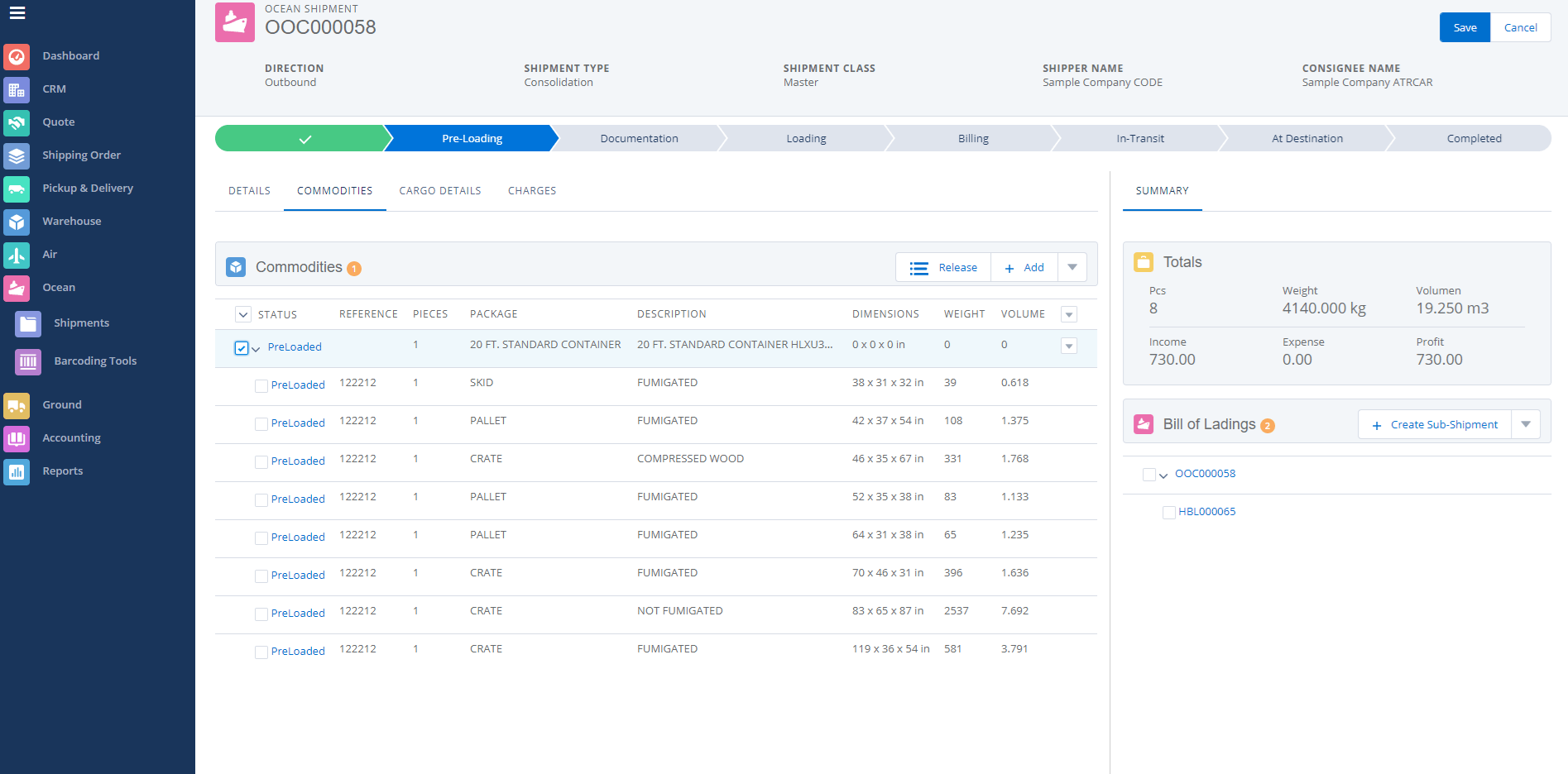
Order management in Linbis
Another advantage of comprehensive platforms is efficient data exchange so that order details are easily shared with other modules (warehousing, invoicing, reporting, etc.).
Warehouse management
Not all freight forwarders offer storage and related services, but those who do would definitely benefit from the warehouse management (WMS) module. It helps plan and optimize storage space, track inventory, control picking and packing activities, coordinate staff, and get greater visibility into all warehousing aspects.
Load planning and consolidation
If you focus on consolidating partial shipments, this part is for you. Booking space for a container and sending it half-empty is not efficient, so a load planning or consolidation module can help you manage LCL shipments and combine them for utmost profitability. Having all the freight details in your system, you can create loading plans, compare costs, generate loading instructions, and so on.
Documentation management
Freight forwarding involves dealing with tons of documents. One of the main features of freight forwarding software is the capability to automatically generate BOLs, AWBs, customs documents, and so on. Not only does it save time, it also reduces errors and the need for paper record keeping.
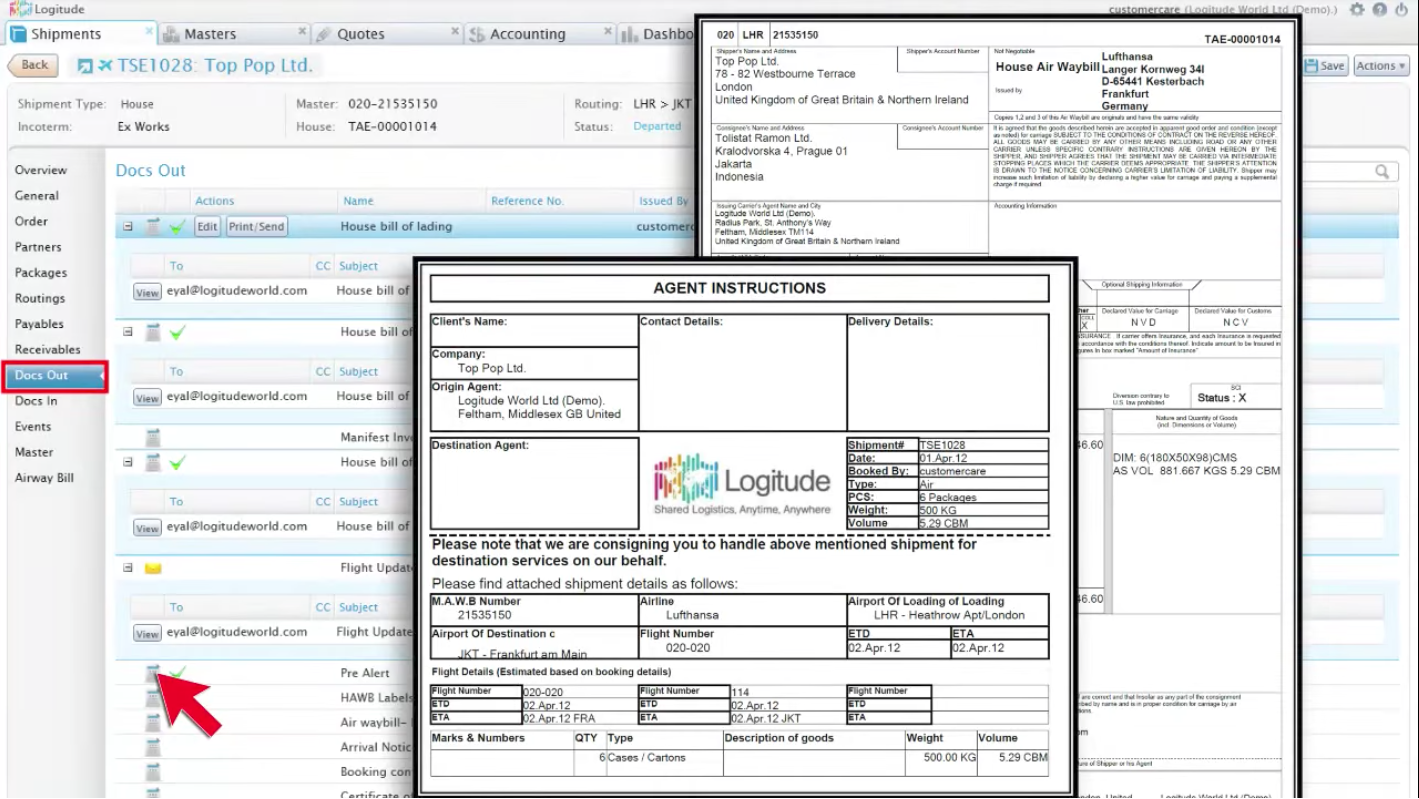
Creating documents in Logitude
Storing documents is yet another issue. If you have heaps of printed quotes, sales orders, BOLs, warehouse documents, invoices, and other paperwork on your desk, you’re unlikely to perform well. The software allows you to keep it all organized, so that you can easily find, retrieve, monitor, and share important documentation associated with all your shipments. With digital document exchange functionality, you can quickly transfer contracts and other documents in multiple formats.
Shipment tracking
Tracking is one of the most crucial parts of the transportation process since all the parties involved always want to know where the shipment is. Today, due to the Internet of Things (IoT) and telematics technologies, carriers can provide real-time tracking information and ETA forecasts.
To have access to this information, most freight forwarding software platforms are integrated with the main transportation services providers. Once tracking data is collected, freight forwarders have several options of keeping their customers posted:
- send regular updates (manual or automated) via email or text,
- give access to data via a set of APIs if shippers want to monitor delivery status through their own system, or
- enable self-tracking through the website or customer portal.
Customer portal
Since ATMs were invented in the 1960s, the popularity of self-service is only growing. Freight forwarding isn’t an exception. Shippers want to be in control of the process and easily get answers to their questions, so it’s worth offering them a customer portal where they can request a quote, download documentation, track their shipment, consult a help desk, or even pay for your services via an integrated payment gateway.
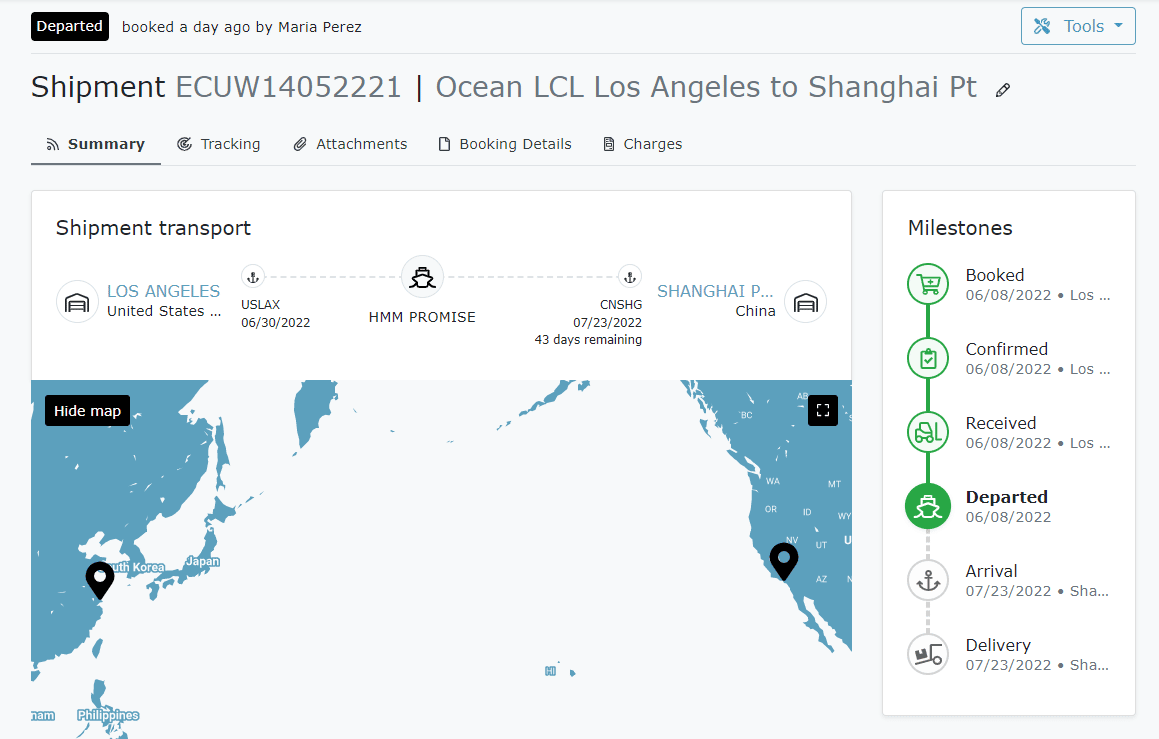
Magaya web portal
Customs and regulatory compliance
Businesses that ship internationally have to comply with multiple regulations of different countries. Software can help you manage those compliance requirements by automating the filing process, electronically submitting customs documentation, performing denied party screening across multiple lists, notifying you about regulatory updates, etc.
CRM
Freight forwarding is a service business, so it’s vital to manage customer relationships properly to enhance loyalty and drive sales. A well-built CRM not only stores all the customer-related details but also helps you to analyze and score leads, manage sales, conduct and monitor marketing activities, and automate your communication with current, past, and potential clients. Some of the specific features include
- automated email replies and notifications,
- dashboards with leads status,
- automated follow-up activities,
- interaction logs and order/shipment history,
- sales KPI reporting, and more.
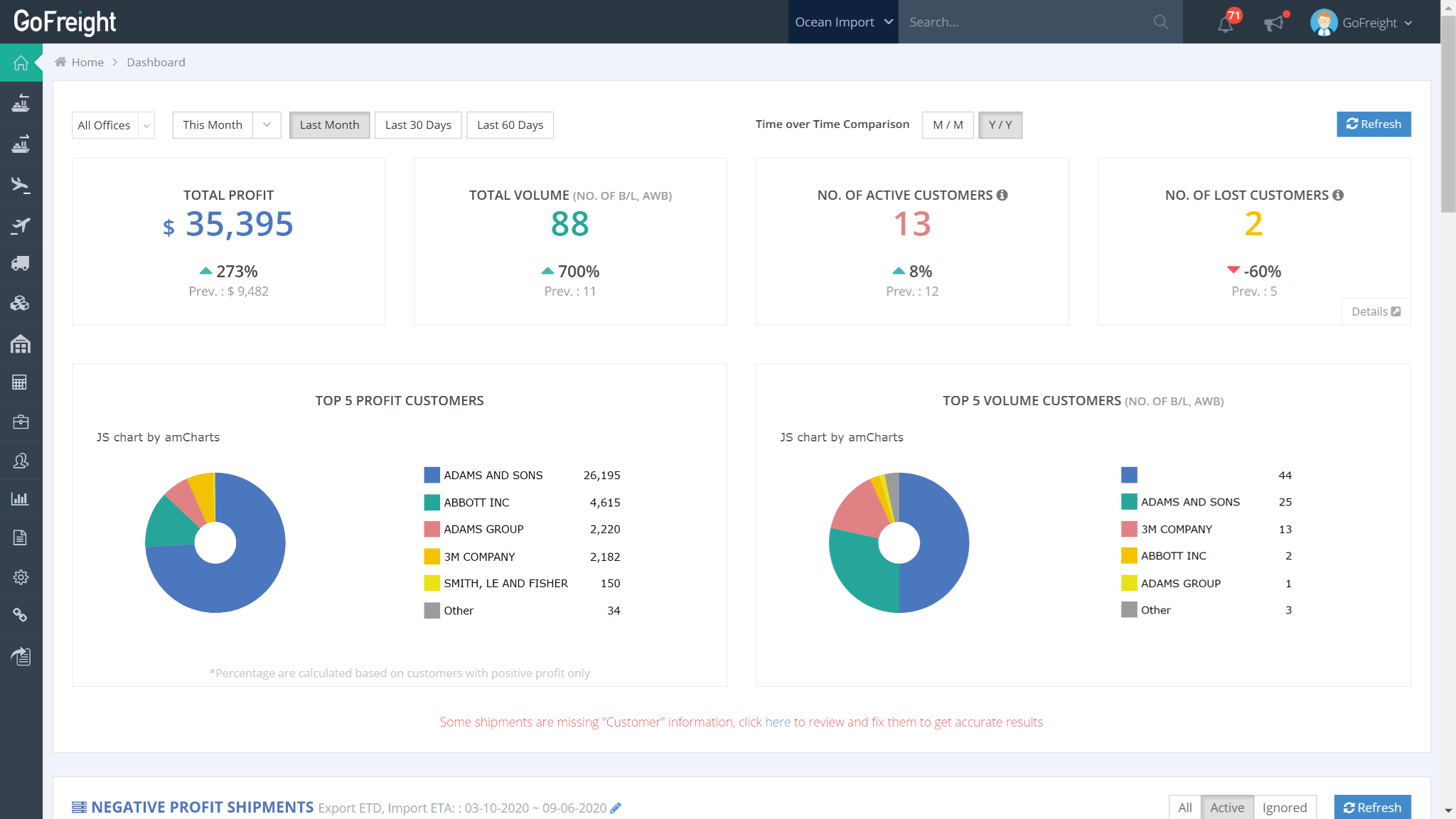
GoFreight reporting dashboard
Invoicing
Financial aspects demand accuracy and an invoicing module helps efficiently handle all accounting operations. You can automatically generate invoices, send them to your customers, and track their status. You can also manage incoming bills from your partners such as carriers, customs, brokers, and so on.
Since freight forwarders deal with international customers and partners, they need to handle multi-currency invoices and payments and the software helps them handle such transactions.
Reporting and analytics
Analytics is an essential factor of business growth and development. You can’t know how well you’re performing and what your opportunities for improvement are if you don’t collect and analyze data, so a reporting and analytics module will give you a bird’s-eye view of your company’s operations. Moreover, it’s vital to observe existing trends to be able to make forecasts and plan on future activities.
External integrations
We’ve already mentioned the importance of integrations. In addition to incorporating freight forwarding software into the internal IT ecosystem, it has to be connected to air, ocean, and land carriers (via either API or EDI) to view their availability and rates, book space, generate and send documentation, monitor shipment status, and more.
Now that you know what to look for in freight forwarding software, let’s sneak a peek at the market and see what it can offer.
Freight forwarding software providers
There are many logistics management systems and transportation management systems that can work for freight forwarders, but we’ll focus on the most specialized solutions that have gained popularity and industry recognition.

Freight forwarding software providers compared
Magaya: a robust product that covers all the main workflows
The Magaya Digital Freight Platform is actually a suite of products that includes
- Magaya Supply Chain that covers logistics and warehousing workflows,
- Magaya Digital Freight Portal that gives your customers control and visibility over their shipments,
- Magaya Rate Management that helps search for rates, manage margins, and create share quotes,
- Magaya Customs Compliance that streamlines compliance workflows, and
- Magaya CRM that’s designed for customer and sales process management.
The platform also has a number of extensions which are basically a bunch of integration options to connect to carriers, customs, tracking solutions, accounting tools, and other external systems.
Language. Magaya is available in English, Spanish, and Portuguese.
Price. Pricing starts from $210/user/month. For an exact quote, you have to contact the provider directly.
User reviews. Magaya users like the ease of operation, system performance, and having all the functionality in one system, as well as the robust capabilities of every separate module.
Descartes: multiple logistics tools with a focus on self-services and data
Descartes offers multiple logistics solutions for different needs – including the Broker & Forwarder Enterprise Systems. The platform streamlines shipment management, customs compliance, accounting, and customer relationship management.
Descartes also puts a big focus on enhancing customer self-service, so you can take advantage of a multifunctional branded portal enabling your clients quote, book, and track shipments.
Descartes is the provider that understands the value of data, so it offers a powerful business intelligence solution and a lead generation tool. Plus, there’s a global trade data library and trade content solutions to enhance such external platforms as Oracle Global Trade Management and SAP Global Trade Services.
Enterprise logistics businesses can benefit from other Descartes products that can be seamlessly integrated, e.g., a TMS, a routing tool, or B2B connectivity solutions.
Language. Descartes solutions are available in 11 languages.
Price. The basic cost of a license starts from $290 per user/month. For exact rate estimation, contact the provider directly.
User reviews. Users appreciate the tracking capabilities, as well as the customs and reporting modules. Also, the fixed pricing system is convenient and benefits growing businesses. However, there are some complaints about slow customer support and system performance after updates.
Logitude: comprehensive solution for small and mid-size businesses
Logitude World is a full-lifecycle solution initially managed by CHAMP Cargosystems and designed for small and medium-sized freight forwarding companies. Its main modules are
- Shipments,
- Quotes,
- CRM (only available in the First Class pricing plan), and
- Invoicing/Accounting.
The INTTRA feature included in all pricing plans enables connection to ocean carriers. The two top-tier plans give access to additional tools like Track & Trace that allows you to monitor the shipment status or the cross-docking feature for advanced warehousing and yard management operations.
Among other business tools, Logitude provides customization and personalization instruments, as well as integration with several accounting platforms.
Logitude also offers the eAWB and CRM as separate solutions.
Language. Localization is available but you have to contact them directly for the options.
Price. There are three pricing plans. The cost of the Economy plan is $39/user/month billed annually (if you pay monthly, it will be more expensive). You’ll be charged $65/user/month for a Business plan and $79/user/month for the First Class. There’s also a 30-day free trial period.
User reviews. Most reviews mention great customer support, fast implementation, and ease of use. Except for minor functionality gaps, users report excellent feature coverage.
GoFreight: user-friendly software with holistic accounting module
GoFreight is an all-in-one suite of tools with features designed mainly for North American freight forwarders. It automates quotation, operations, shipment management, and accounting workflows. The platform also offers custom documentation filing and reporting capabilities.
The tracking module with API/EDI connectivity and a customer portal are optional add-ons.
Language. GoFreight is available in English and Chinese.
Price. Pricing for GoFreight depends on the user number, shipment volume, and selected add-ons. Contact the provider for a quote.
User reviews. Users enjoy the intuitive interface and affordability, as well as praise the accounting functionality. However, some report insufficient WMS and quotation capabilities.
How to choose freight forwarding software: final recommendations
It’s obvious that the two main factors to consider when choosing any software are functionality and price. You wouldn’t buy a comprehensive enterprise platform if you don’t need half of its features (say, you don’t operate a warehouse or a fleet of trucks but only arrange ocean transportation). Luckily, there are many modular solutions that you can choose from – and only pay for what you get.
Hidden costs. When comparing your options, don’t forget to assess the hidden costs such as support, training, integrations, maintenance, etc.
Customization. If you can’t find any off-the-shelf product that covers your workflows, you can either buy several tools or get the most suitable one and then customize it to fit your business needs. If it lacks customization options, you’ll have to engage IT specialists to tailor the selected software for you.
Integration into your IT ecosystem. It’s totally essential to integrate the new software with other internal systems to establish seamless data flow within your organization.
External integrations. Be sure to check which external integrations come out of the box and whether they include your business partners (carriers, customs, 3PLs, etc.). Ask your provider if they can add the connections you need. If not, you’ll have to build them yourself (with the help of IT professionals, of course).
Other aspects. There’s more to take into account than the list of features. Before you commit to a subscription, be sure to talk to the vendor about
- implementation support (will their specialists assist with initial deployment?),
- customization options (can their specialists fine-tune the product to your needs?),
- scalability of the product (will it be able to support your growth?),
- data security (is it compliant with security standards?),
- customer support (how fast do they react to tickets and what does its cost?), and
- training options (will they teach your staff to use the product?).
Whether you run a small company and want to cut costs and set up effective business processes – or operate an enterprise and think of providing more services while increasing efficiency, well-built, integrated technology will streamline your operations, enhance performance, and let you achieve best results.
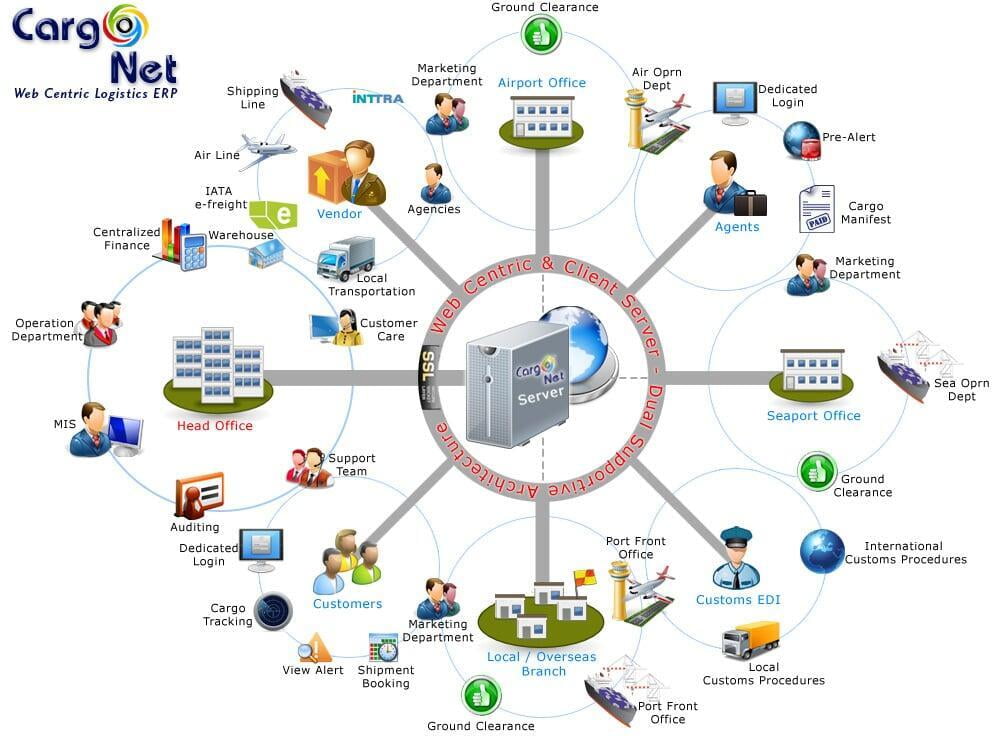
CARGO MANAGEMENT SYSTEM
CargoNet functions at different segments, providing functionality required for each level which are independent as well as interdependent on the other segments of the Supply Chain System. This includes Freight Forwarders, CHAs, Transporters, Overseas Agents, Shipper, Consignee, Ports etc. CargoNet is a complete Framework of Solutions for the entire Supply Chain system. It pieces together all the parameters of the Supply chain into a single Entity
Key Features
- Unparalleled Real Time Connectivity between various Entities in the Supply Chain System
- Clear visibility of Entity wise operations at various stages from planning to Shipment Delivery
- Detailed and Consolidated reporting for Management Framework & Operational Framework
- Financial Framework
- Tracking & Communication Framework
- IATA, Agent, Ports, Branch Framework
- Clear & Visible Shipment Tracking at every stage based on Roles
- Device independent Communication and Information Interchange covering the Most advanced Gadgets like PDAs and other Hand Held Devises
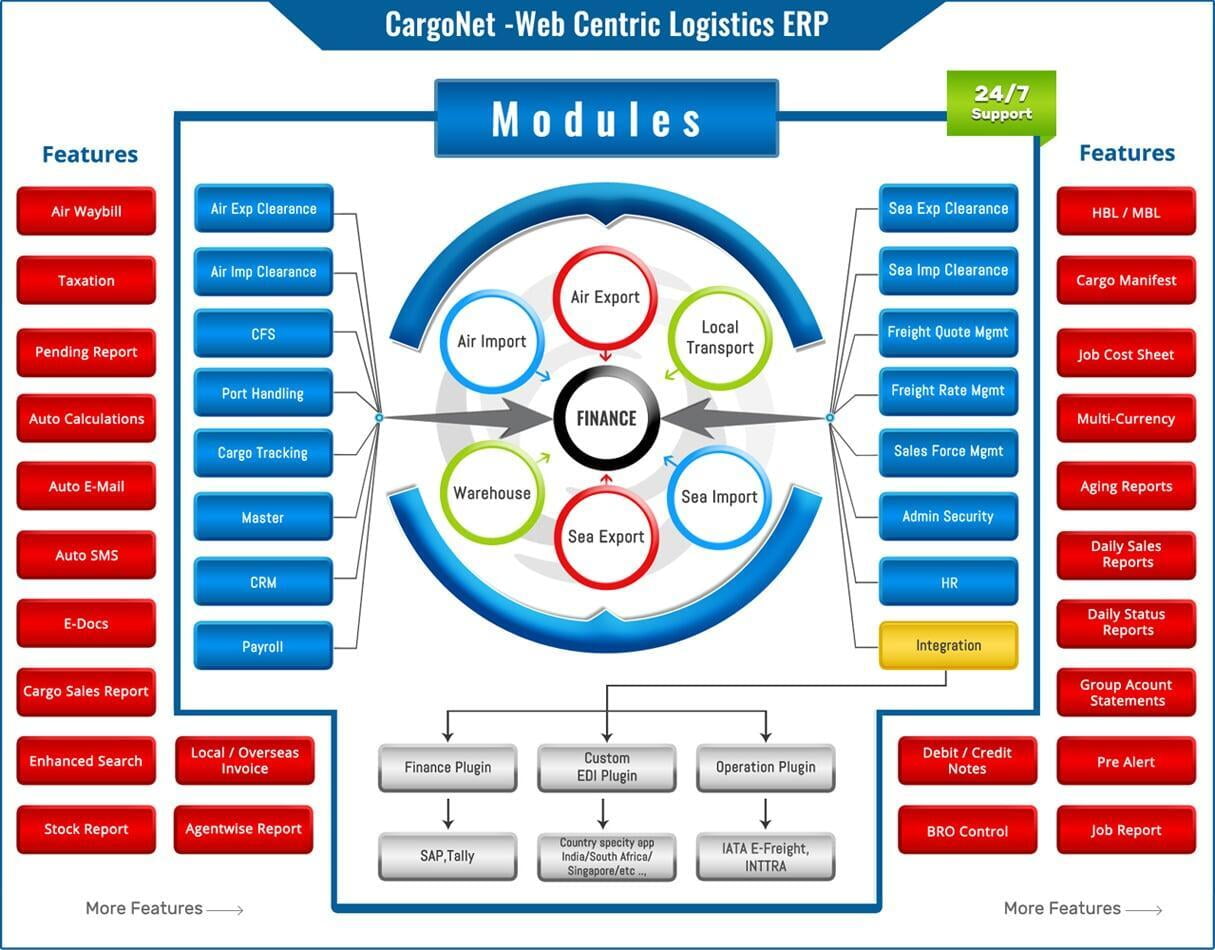
Movements International has been using ERP for Freight Forwarding system since 2015, which is a single centralized framework to integrate and automate all Operational and Financial processes for a Logistics Firms , with the aim of increasing operational efficiency and improving the accessibility and flow of information across all departments and Branches.
Availability of timely and Accurate Shipping Information to Customers, Overseas Agents. Powered by the innovative concepts like Auto e-mailing, Auto SMS, e-Docs and much more… Cargo Net enables organizations to respond and adapt quickly to the changing marketplace and business environment in a more efficient and Customer friendly manner
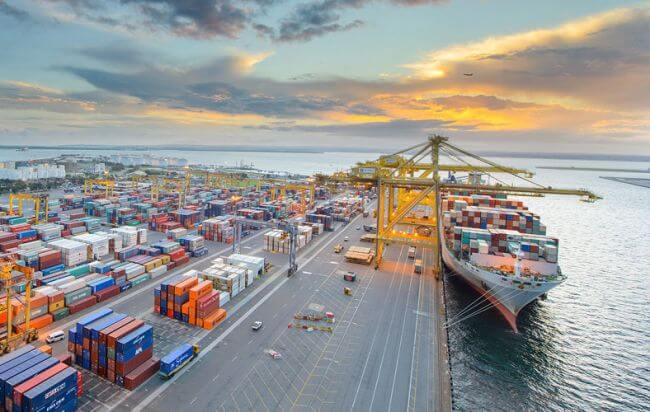
SEA EXPORT - SOP
Cargo Management System ( CMS ) is designed to support export logistics at two functional levels. Pre shipment and post shipment and starts capturing data at request from shipper for export.
Pre-Shipment Activity
With the help of CMS Freight forwarders can complete their all pre shipment activities while conforming to the Standard Operating Procedures. The CMS pre shipment system supports all activities from initial Customer request for export till the cargo reaches the desired port and ready for shipment.
Request from Shipper
The CMS Booking module effectively captures the complete booking information regarding Shipper, Consignee, Notify parties, route, containers required and so forth.
Shipment in Transit
While the shipment is in transit, the forwarder and approved agents can access the cargo tracking feature of CMS to constantly update the in-transit status. The updated status is immediately reflected in the freight forwarder website. The status can be known by BL number, Job number, Container number and a host of other customizable parameters.
Container Selection
Now freight forwarders can reliably depend on CMS 3-D container visualization to help their customers in deciding the numbers and type of containers best suited for cargo fitment virtually. This process besides conforming to the SOP also helps the Freight Forwarders to plan their shipment schedule depending on the delivery dates.
IGM Filing
The Overseas agent Files the Import General manifest via the CMS EDI module. Once the IGM is filed online, the custom authorities evaluate the IGM and the acknowledgement is reflected in CMS module regarding the date of inspection based on which the containers are ready for customs inspection.
Shipment Confirmation
Once the shipment is created the freight forwarder’s operation team creates jobs from CargoNet by just importing data from Booking and adding other information related to she shipment. CargoNet gives the freedom to generate House BLs with a single click in case of consolidated shipments and option for Master BL creation with a single click data import. CargoNet supports BL printing on Customized statutory formatted BL and Draft copy. Customers, agents and other entities in the supply chain can get instant shipment information via CargoNet’s automated mailing and SMS from within the module rather than having to depend on external mailing systems.
Cargo offloading at destination port
When the cargo is offloaded at the destination port, the containers are temporarily stationed at the port before being taken up for customs inspection. This requires the utilization of Container Freight Stations. The CargoNet CFS module plays a vital role in monitoring the containers at the station and efficiently calculates the rent calculations, invoice and purchase bills generation, destuffing procedures if any and so forth. Automated calculations in CargoNet CFS enables port authorities to significantly save on man hours and get accurate calculations based on rates that may fluctuate.
Liner Interactions
With the help of CargoNet’s Freight Rate management module, freight forwarders gain the benefit of offering the best rates to their customers. The module offers extensive support to get online information liner rates by the minute. The Freight Quote module of CargoNet helps freight forwarders Sales Force to prepare instant quotes no matter where they are located from their lap tops and send to the customers. This saves a lot of company’s and customer’s time.
Customs Clearance
Once the IGM has been filed through CargoNet, the customs clearance procedures start. CargoNet Customs Clearance module in combination with Customs EDI helps the freight forwarders to quickly clear off the customs procedure and take out te cargo for delivery.
Packing & Containerization
The CFS module of CargoNet takes care of the complete operational and documentation processes related to this process. The software is very much helpful to the freight forwarders for Load matching and Container load planning activities.
Port handling procedure
Once the customs clearance procedures are through the freight forwarders can quickly logon to the Port handling procedure of CargoNet to complete the formalities associated with the port. CargoNet Port handling procedures make sure that the receivable and payables associated with port handling are completely covered. Some of the major aspects covered by CargoNet are- Destination Terminal Handling procedures
- Destination Documentation procedures
- Merchant Haulage procedures
- Additional container movement at the terminal, including Customs Inspection
- Container weighing procedures at the terminal
- Port security procedures
- Transport Document Amendment procedures
- Railroad Bill of Lading procedures
- Currency Change procedures
- Transport Document procedures
Local Transportation & Cargo Delivery
Once the cargo is released from port premises, CargoNet Local Transportation module helps in keeping track of the shipment and related process handling from the delivery port to the consignee premises.- Advance receipts and payments handling
- Customs Duty, Taxes and other statutory processes handling
- Port /Warehouse charges handling
- Transhipments handling
- Door Delivery processes handling
Customs' Clearance
CargoNet export clearance module combined with EDI interface and plug-in effectively handles all the processes related customs clearance, online document submission. The system automatically generates all the statutory reports and documents instantly saving a considerable amount time and cost to the freight forwarder.
WarehousingThe comprehensive CargoNet warehouse module collects data right from unloading, to palletizing, Binning, bar coding till the cargo has moved out of the warehouse. This module is equipped with warehouse cargo inspection, inventory management, cargo storage, and in-transit transportation processes and generates required statutory documents and finance related reports to the freight forwarder.
Land TransportThe CargoNet Local Transportation module handles all the processes and statutory documents generation related to goods in transit from shipper warehouse to the ports. Job creation, Trip sheets, invoicing and expense voucher handling are integral part of CargoNet. Cargo tracking module helps the freight forwarders to keep track of shipments at every point.
Invoicing & Billing
Freight forwarders can generate standardized invoices and billing to the customers and manage their buying and selling effectively. The system keeps track of every single penny spent and earned and generates accurate statutory and management reports. TDS, Service taxes and other related aspects are completely taken care by CargoNet.
Export benefit schemes for Shipper
This special feature introduced in CargoNet goes a long way in not only simplifying the freight forwarders job of co-ordination with the CHA in getting the export benefits for the shipper, but also gives a boost to the Customer faith in the freight forwarders customer commitment. CargoNet in this way is also benefiting the customer’s customer. Some of the export schemes covered by CargoNet are- Advance licence for intermediate supplies
- Advance licence
- Advance release order
- Advance licence for deemed exports
- DEPB post export
- Replenishment licence
- Diamond imprest licence
- Concessional duty EPCG scheme
- Zero duty EPCG scheme
- Duty free replenishment certificate?
- Drawback and advance licence
- Drawback and concessional duty EPCG
Shipment on Board
Once the shipment is on board and set sail, the freight Forwarder can send automated mails from CargoNet to concerned parties like shipper, consignee and overseas agent. Pre-Alert can be generated from CargoNet with a single click data import from Job and can be instantly mailed from within the system. The system also has an option of instant messaging SMS which is built in.Shipment at Port
Once the shipment arrives at the port much before the scheduled despatch date and may need to be anchored at the port. The CargoNet Port handling module effectively addresses this by keeping track of cargo movement within the port, containers stored temporarily halted in the ports, handling operational and finance activities, generating documents and reports related to statutory and management levels.
SEA EXPORT - SOP
Pre-Shipment Activity
Request from Shipper
Shipment in Transit
Container Selection
IGM Filing
Shipment Confirmation
Cargo offloading at destination port
Liner Interactions
Customs Clearance
Packing & Containerization
Port handling procedure
- Destination Terminal Handling procedures
- Destination Documentation procedures
- Merchant Haulage procedures
- Additional container movement at the terminal, including Customs Inspection
- Container weighing procedures at the terminal
- Port security procedures
- Transport Document Amendment procedures
- Railroad Bill of Lading procedures
- Currency Change procedures
- Transport Document procedures
Local Transportation & Cargo Delivery
- Advance receipts and payments handling
- Customs Duty, Taxes and other statutory processes handling
- Port /Warehouse charges handling
- Transhipments handling
- Door Delivery processes handling
Customs' Clearance
- Advance licence for intermediate supplies
- Advance licence
- Advance release order
- Advance licence for deemed exports
- DEPB post export
- Replenishment licence
- Diamond imprest licence
- Concessional duty EPCG scheme
- Zero duty EPCG scheme
- Duty free replenishment certificate?
- Drawback and advance licence
- Drawback and concessional duty EPCG
Shipment on Board
Shipment at Port

AIR EXPORT - SOP
- Sales Lead Management
- Airline negotiations management
- Order management
- Documents generation
- IATA procedures and process management
- Customs Clearance & Customs EDI
- Warehousing
- Local Transportation
- Cargo Tracking
- Cargo delivery
- Passing on Air Export benefits to Customers
Sales Lead Management
Customs Clearance
Airline negotiations management
- Automated rate calculations based on shipment details
- Maintenance of tariff rates and documentation procedures
- Maintaining special prorate agreements
- Supporting ad-hoc rate management
- Supporting multiple modes of payment and multiple currencies
- Delivering price quotations via automated mails and automated SMS channels
Order Management
Warehousing
Local Transportation
- Transportation mode selection
- Route Planning & in-transit time optimization
- Cost optimization
- Packing and loading
- Delivery Challan and road papers generation
- Insurance coverage against in-transit damages
- Mileage and Rate calculations
- Vehicles maintenance
- Vehicles servicing
- RFID
- Cargo Delivery at port and POD generations
- Shipper yard to port and Port to Consignee yard delivery management
Documents generation
- Airway Bill
- Commercial Invoice
- Export Packing List
- Shippers Export Declaration
- Generic Certificate of Origin
- IATA Temporary shipment certificate
- Dangerous Goods Certificate
- Inspection Certificate
- Insurance Certificate
- Shippers Letter of Instruction
- Customs Certificate of Registration
IATA procedures and process management
- Chargeable/volumetric weight
- Air freight calculations
- Unit Load Device charges
- Consolidation
Cargo Tracking & e-docs management
Cargo delivery
Passing on Air Export benefits to Customers
- Duty exemption schemes
- Drawback and post export benefits
- Drawback and EOU/EPZ/SEZ
- Advance license for exports
- Drawback and zero duty EPCG etc...

SEA IMPORT - SOP
CargoNet is designed to support export logistics at two functional levels. Preshipment and post shipment. CargoNet starts capturing data at request from shipper for export.
CargoNet's Pre-Shipment Activity
Request from Shipper
Container Selection
Liner Interactions
Shipment in Transit
Shipment Confirmation
Cargo offloading at destination port
IGM Filing
Customs Clearance
Invoicing & Billing
Packing & Containerization
Land Transport
Customs' Clearance
Port handling procedure
- Destination Terminal Handling procedures
- Destination Documentation procedures
- Merchant Haulage procedures
- Additional container movement at the terminal, including Customs Inspection
- Container weighing procedures at the terminal
- Port security procedures
- Transport Document Amendment procedures
- Railroad Bill of Lading procedures
- Currency Change procedures
- Transport Document procedures
Warehousing
Shipment at Port
Local Transportation & Cargo Delivery
- Advance receipts and payments handling
- Customs Duty, Taxes and other statutory processes handling
- Port /Warehouse charges handling
- Transhipments handling
- Door Delivery processes handling
Shipment on Board
Export benefit schemes for Shipper
- Advance licence for intermediate supplies
- Advance licence
- Advance release order
- Advance licence for deemed exports
- DEPB post export
- Replenishment licence
- Diamond imprest licence
- Concessional duty EPCG scheme
- Zero duty EPCG scheme
- Duty free replenishment certificate?
- Drawback and advance licence
- Drawback and concessional duty EPCG

AIR IMPORT - SOP
The CargoNet Air Import module is effectively linked with the other modules of CargoNet to streamline and simply the import shipments processes for the freight forwarders and their customers. The process starts from import shipment booking and culminates in cargo delivery at the consignee yard.
Air Import enquiry
Process AWB/Packing List & Invoices
Container Selection
Liner Interactions
Shipment in Transit
Shipment Confirmation
Cargo offloading at destination port
IGM Filing
Customs Clearance
Invoicing & Billing
Packing & Containerization
Land Transport
Customs' Clearance
Port handling procedure
- Destination Terminal Handling procedures
- Destination Documentation procedures
- Merchant Haulage procedures
- Additional container movement at the terminal, including Customs Inspection
- Container weighing procedures at the terminal
- Port security procedures
- Transport Document Amendment procedures
- Railroad Bill of Lading procedures
- Currency Change procedures
- Transport Document procedures
Warehousing
Shipment at Port
Local Transportation & Cargo Delivery
- Advance receipts and payments handling
- Customs Duty, Taxes and other statutory processes handling
- Port /Warehouse charges handling
- Transhipments handling
- Door Delivery processes handling
Shipment on Board
Export benefit schemes for Shipper
- Advance licence for intermediate supplies
- Advance licence
- Advance release order
- Advance licence for deemed exports
- DEPB post export
- Replenishment licence
- Diamond imprest licence
- Concessional duty EPCG scheme
- Zero duty EPCG scheme
- Duty free replenishment certificate?
- Drawback and advance licence
- Drawback and concessional duty EPCG
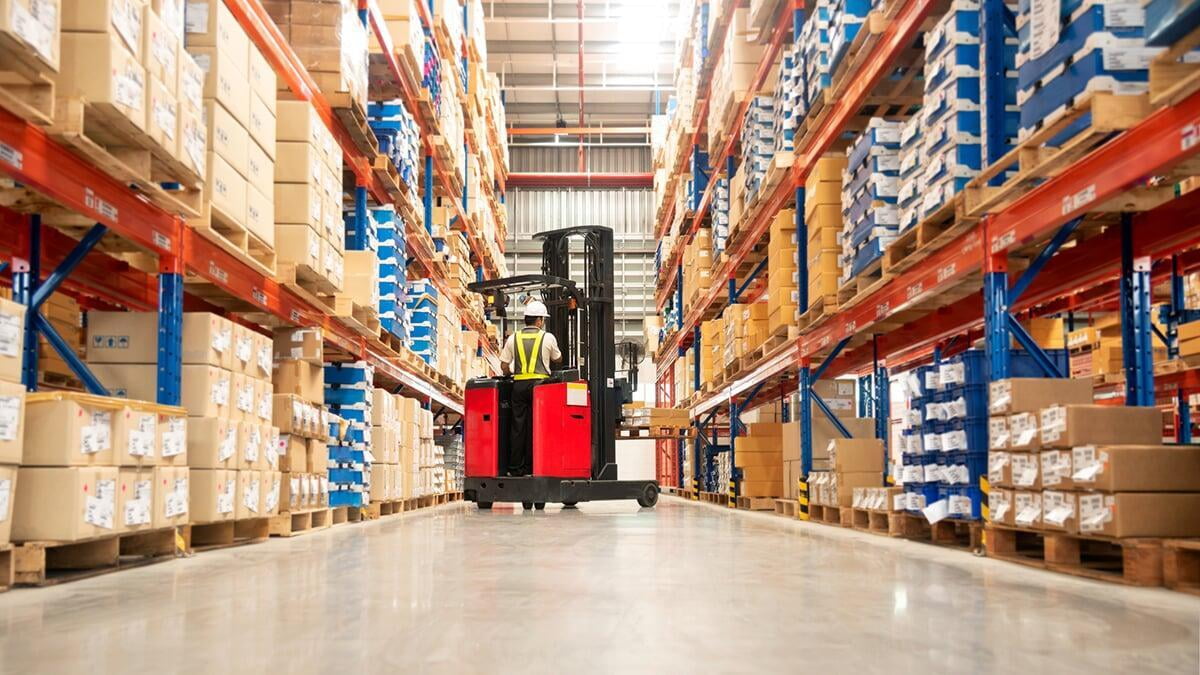
CARGO FREIGHT STATION - SOP
CARGO FREIGHT STATION - SOP
- Container arrival at the station
- Container warehousing
- Container and Cargo inspection
- Yard management
- Container stuffing and destuffing
- Container servicing and maintenance
- Terminal operations handling
- Invoice and bills generation
- Customer and Vendor communication management
- Finance integration
- Container clearance from the CFS
CARGO WAREHOUSE MANAGEMENT SOFTWARE
Warehouse management software(WMS) a powerful tool for streamlining the management of warehouses storage and retrieval of goods or fulfillment center. The system is designed to keep track of inventory, storage, shipping and receiving processes, as well as provide other useful features like picking and packing.
Warehouse management software is a computerized inventory tracking system that is designed to make your job easier by automating many of the processes involved in managing your warehouse. With this type of program, you can conduct real-time inventories on all of your products, monitor sales and purchasing patterns, automate the placing of orders and automate the allocation of incoming deliveries to different storage locations within your warehouse. This can greatly reduce the amount of time that you spend on these tasks.
The CargoNet Cargo Warehousing Management Software module extensively covers all the incoming, storage and outgoing operations involved in Logistics Warehouse management. a powerful tool for streamlining the management of warehouses
A number of parameters have been considered while designing the Warehouse module they can be listed as
- The volume of goods.
- Speed of through-put required.
- Warehouse as a transit point
- Breaking bulk location
- Warehouse as an area for sorting and consolidating different goods.
- To enhance the speed of the response
- To protect and account for inventor
- Warehousing system as a buffer in the event of a break-down or delay in the supply pipeline.
CargoNet Cargo Warehouse Management Software module focuses on four of the main activities of an efficient warehouse.
- Cargo receipt
- Cargo Storage
- Cargo Picking
- Cargo dispatch
CargoNet helps in effective inventory management. The warehouse Management Software module is designed to handle initial and in-transit warehousing operations. Inventory management involves many complex procedures which have been simplified to a large extent by CargoNet Warehouse Management Software module.
- Order lead time tracking and planning
- Tracking orders for Cargo
- Controlling stock movements
- Establishing minimum stock levels and monitoring the same
- Cargo receipt quality inspections
- Physical stock control in the warehouse
- Controlling Specialised Items
- Releasing stock from storage and Cargo despatch
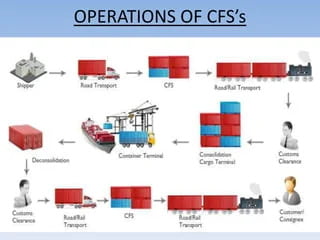
SEA CARGO FREIGHT STATION - SOP
SEA CARGO FREIGHT STATION - SOP
- Container arrival at the station
- Container warehousing
- Container and Cargo inspection
- Yard management
- Container stuffing and destuffing
- Container servicing and maintenance
- Terminal operations handling
- Invoice and bills generation
- Customer and Vendor communication management
- Finance integration
- Container clearance from the CFS
CARGO WAREHOUSE MANAGEMENT SOFTWARE
Warehouse management software(WMS) a powerful tool for streamlining the management of warehouses storage and retrieval of goods or fulfillment center. The system is designed to keep track of inventory, storage, shipping and receiving processes, as well as provide other useful features like picking and packing.
Warehouse management software is a computerized inventory tracking system that is designed to make your job easier by automating many of the processes involved in managing your warehouse. With this type of program, you can conduct real-time inventories on all of your products, monitor sales and purchasing patterns, automate the placing of orders and automate the allocation of incoming deliveries to different storage locations within your warehouse. This can greatly reduce the amount of time that you spend on these tasks.
The CargoNet Cargo Warehousing Management Software module extensively covers all the incoming, storage and outgoing operations involved in Logistics Warehouse management. a powerful tool for streamlining the management of warehouses
A number of parameters have been considered while designing the Warehouse module they can be listed as
- The volume of goods.
- Speed of through-put required.
- Warehouse as a transit point
- Breaking bulk location
- Warehouse as an area for sorting and consolidating different goods.
- To enhance the speed of the response
- To protect and account for inventor
- Warehousing system as a buffer in the event of a break-down or delay in the supply pipeline.
CargoNet Cargo Warehouse Management Software module focuses on four of the main activities of an efficient warehouse.
- Cargo receipt
- Cargo Storage
- Cargo Picking
- Cargo dispatch
CargoNet helps in effective inventory management. The warehouse Management Software module is designed to handle initial and in-transit warehousing operations. Inventory management involves many complex procedures which have been simplified to a large extent by CargoNet Warehouse Management Software module.
- Order lead time tracking and planning
- Tracking orders for Cargo
- Controlling stock movements
- Establishing minimum stock levels and monitoring the same
- Cargo receipt quality inspections
- Physical stock control in the warehouse
- Controlling Specialised Items
- Releasing stock from storage and Cargo despatch

SHIP AGENCY - SOP
SHIP AGENCY - SOP
StandardOperating Procedure – Ships Agency
1. Applicability and Scope
The Standard Operating Procedure(SOP) is the basic minimum required Procedure for Ships Agency – Sub-Agency Operations. Customer specific requirements prevail over the Movements International Ships Agency standard requirements.
2. Purpose
The sop is to give clear guidance for Movements International Employees and Sub-Agents to provide scandalized and High Quality Agency Services Throughout the fiji port services network. It sets a standard focusing on the most important issues that will make a different to our customers.
3. Description
1 Introduction to Port Services–Sub Agency Standard OperatingProcedure
ThisSOPfollowsthedifferentoperationalandfinancialstagesintheport
AdefinitionforImmediatelyand OperationalKPIs willbedeterminedby PortServices and will consider customer requirements, operational capabilities and local regulations.
2 SafetyandQuality
WilhelmsenoperatesShipsAgencyservicesinaccordancewithdefinedSafety,Security and Quality Commitments and our Supplier Code of Conduct.
| Safety and Quality Commitment |
| We are committed to deliver quality Ships Agency services in compliance with our Standards and procedures by: |
| Maintaining high standards of health and safety and by preventing accidents and dangerous situations. |
| Adhering to the procedures set out in ISO requirements. |
| Operating in compliance with best practices. |
| Operating in compliance with the GDPR regulation. |
| Reporting incidents and Improvement suggestions to promote continual improvement. |
| Clear Responsibility | Competitive Sourcing | Proactive Preplanning | Positive Attitude |
| Communicate Person responsible for the port call | Use local knowledge of the port and contractors to frequently negotiate and obtain competitive rates for our customers. | Plan in detail every aspect of the port call and keep | Act proactively and communicate in a professional and efficient way. |
3.Sub-AgentStandardOperating
1.1 Foundation :
Ships Agency services are defined in the Sub-Agency Terms & Conditions and the Port Services Supplier Code of Conduct.
Customer specific reporting requirement sprevailoverthe Port Services standard reporting requirements.
The Sub-Agent manages the safe and efficient operation and allocates the required resources to carry out the Ship Agency activities.
The Sub-Agent ensures that all activities are risk assessed and that high standards of health and safety are maintained.
The Sub-Agent ensures his staff is service-minded and understands the importance of timely and precise communication.
Allunexpectedevents,largeorsmall,shallbereportedimmediatelyandinadditiontoroutine
he Sub-Agent is in charge and ensures the deliveries from suppliers are done as per Wilhelmsen Port Services Supplier Code of Conduct.
1.1 KeyPerformance Indicators
| Key Performance Indicators | ||
| Category | KPI | Measurement |
| Enquiry Response | Response to the customer with requested information | Enquiry Response within 3hrs |
| Appointment Acceptance | Customer appointment acceptance, Pre- arrival information and berthing prospects | Appointment Acceptance within 3hrs |
| Arrival Report | Customer Arrival Report sent | Within 3hrs of all fast |
| Update Report | Customer Operations Update Report, Husbandry Services Delivered | Minimum twice daily before agreed time |
| Departure Report | Customer Departure Report or Service Delivery Report sent | Within 3hrs from last line off |
| Revised DA | Close Estimate of Port Expenses (RDA) | Within 72hrs from Departure |
| Final DA | Final DA | 30 days from Departure |
1.1 Requirementsoninformationand
1. Enquiries:
- Allenquiries/estimatemustberespondedto
2. Agency
- Immediately after acknowledging and accepting the nomination, information on port and berth, berthing prospects, Pro-forma disbursement account (PDA) and other relevant info are to be given by email.
- PersoninCharge(PIC)andAfterOfficeHours(AOH)detailsare
3. Pre-arrival:
- Pre-arrival information should contain at a minimum the Port regulation for arriving vessels, terminal/berthtechnicalspecifications,ISPSrequirements,berthingprospects,estimatedport stay and emergency contacts.
- Pre-arrivalupdatesshallbesubmitteddailybefore0900hrsunlessotherwise
Delaysand/orchangestobecommunicatedimmediatelyandthereasonwhy
- Always evaluate alternative operational options and make constructive suggestions in order to expedite vessel turnaround.
- GivenoticetoShippers,Receivers,Consigneesand/orotherrelevantpartiesasper
- For vessels discharging, confirm that the Original Bills of Lading are available or a valid LOI is in place.
- Notify immediately the instructed parties on any communication difficulties, discrepancies or disputes with Shippers or Receivers or other relevant parties.
- Schedule and book all requested services as per requirements and report the progress toinstructed parties.
- Strictlyadheretoalldocumentationandreporting
1. Duringport
Everydeviation fromthe planningis tobe immediately communicated.
- Operationalupdates aresent dailybefore 0900hrs.
- Carryoutallnecessaryarrival
- AdheretoNoticeofReadiness(NOR)requirementsandverifyavailableinformationis
- ComplywithPortServices’,Port/terminal’&customer’PersonalProtective Equipment (PPE) and Safety requirements
- Agentshallboardthevesselonarrival(alongsideoroffshore),unlessotherwiseinstructedor where boarding is restricted by regulations or to be considered as unsafe.
- Alist ofbookedserviceswithstatustobekept upto
- ConfirmstatusofallrequestedservicestoMasteron
- ArrivalReporttobesentimmediatelytopartiesas
- Agenttoattendvesseldailyorasmutually
- Cargo commencement shall be reported immediately to parties as instructed, together with estimated completion time and ETD from berth and port.
- Operational Progress Report, together with ETD shall be sent daily, or as instructed by the
- Immediatelyinformrelevantpartiesintheeventofanyemergency,accidentorpersonal injuries. NEVER DELAY communications on such matters. Call when urgent.
- Neverdelaycommunicationtotherelevantpartiesondelaysorchangestotheplanned operations. Explain the reason why for all stoppages and delays. Call when urgent.
- PortServiceswillbeinformedimmediatelyonrelevantchangestotheport
- Cargocompletionshallbereportedassoonaspossibletothepartiesas
- Carry out all necessary departure formalities and inform the Master on the scheduled departure time.
- Statement of Facts (SOF) shall be updated continuously, and SOF draft has to be sent to Port Services well before ship departure for their final check and confirmation. Oncecompleted, including afull explanation of all delays andstoppages, it will be signedby relevant parties.
- Forloadportcalls,allOriginalBillsofLadingmustbeverifiedbyacompetentoperationsstaff member and the operations manager before releasing.
- Fordischargeportcalls,agentistoconfirmavailabilityofallOriginalBillsofLadingwellbefore ship arrival, which is then to be presented to the Master on arrival.
2. Post–departure:
- DepartureReporttobesentimmediatelytopartiesas
- SOFandrelevantcargodocumentstobesentimmediatelytopartiesas
- Revised DA to be completed and sent to Wilhelmsen Port Services withinagreed timeframe with less than 3% deviation to Final Disbursement Account (FDA).
3. Disbursement&
- FDAissubmittedtoWilhelmsenPortServiceswithinagreed
- Pricingandpaymentschedule,includingpre-fundingandFDAsettlementtermstobeadhered to as per Schedule in the Sub-Agency Agreement.
4. Claims:
- CommunicateanyclaimstoWilhelmsenPortServicesimmediately.

